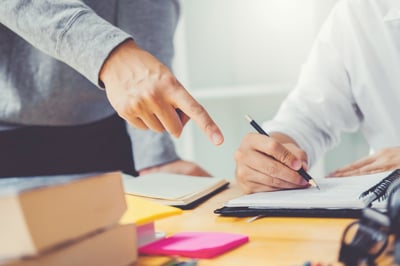8 Tips for Better Listening
Communication continues to be something many of us talk about. A lot. You can read blogs or articles or watch webinars on communication at just about any moment. Any good definition of communication describes it as a loop. The message is prepared and sent by the sender. It is received and decoded by the receiver. Then the receiver sends a confirmation of receipt back to the sender.
 Many messages focus on better preparing and sending our messages more effectively so we can be sure we are heard by the receiver. But in addition to talking about sending communication, we also need to spend some time talking about receiving communication. What if we are the receiver of the communication instead of the sender? How do we listen well? What are our responsibilities as listener to help “close the loop” in a communication?
Many messages focus on better preparing and sending our messages more effectively so we can be sure we are heard by the receiver. But in addition to talking about sending communication, we also need to spend some time talking about receiving communication. What if we are the receiver of the communication instead of the sender? How do we listen well? What are our responsibilities as listener to help “close the loop” in a communication?
Honestly, just as we spend time improving our communication-sending skills, we also need to invest in our own communication-receiving skills.
As with many skills, one technique will not apply in all situations. So, we are here to offer several ideas. All of these tips theme around intentionality. We invite you to consider these tips and make your listening active and intentional.
1. Close your mouth.
 It seems pretty intuitive, but we are so prone to talking that sometimes we just forget to close our mouth and listen. It’s hard to listen when we’re talking. There’s an old adage “God gave us two ears and one mouth. We should use them in that ratio.” But so many of us are too quick to speak. If you are good at keeping your mouth shut while you listen, awesome! If this is something you still need to work on, try using a physical prompt, like holding on to a pen or a business card, as a reminder to keep your lips pressed together in silence until the other person has had a chance to finish.
It seems pretty intuitive, but we are so prone to talking that sometimes we just forget to close our mouth and listen. It’s hard to listen when we’re talking. There’s an old adage “God gave us two ears and one mouth. We should use them in that ratio.” But so many of us are too quick to speak. If you are good at keeping your mouth shut while you listen, awesome! If this is something you still need to work on, try using a physical prompt, like holding on to a pen or a business card, as a reminder to keep your lips pressed together in silence until the other person has had a chance to finish.
2. Prepare.
Sometimes we need to mentally prepare ourselves to listen. Other times, we need to physically prepare by removing the distractions from the space or the distractions from ourselves. Regardless of the type of preparation you need, it is important to actively and intentionally prepare for the exercise of listening. Do what you need to do to prepare yourself to focus, stay quiet, and listen for understanding. Try some of these ideas to prepare:
- Turn your phone to do not disturb mode.
- Close the door.
- Take a drink of water or have a bite to eat so you aren’t distracted by a dry mouth or a growling stomach.
- Get a notepad and pen ready so you can take notes.
- Prepare questions you might hope are answered in the communication, or jot down what you perceive to be your goal of the exchange.
- Take a moment to bring positive feelings to the surface about both the topic at hand and the communicator.
3. Ask questions.
 While it might seem counter-intuitive, asking questions is a key part of listening. Sometimes we ask questions for our own benefit, ensuring that we’ve understood what has just been said. Sometimes we ask questions for the benefit of the person we’ve been listening to. You may have had to prepare questions in advance as part of your preparation. As you’re listening, consider your questions and see if they’ve been answered. If not, ask. If you don’t think you’ve understood, ask a question to get to the bottom of it. If you think you’ve understood, but you’re communicating with someone who values your engagement in the discussion, then ask questions.
While it might seem counter-intuitive, asking questions is a key part of listening. Sometimes we ask questions for our own benefit, ensuring that we’ve understood what has just been said. Sometimes we ask questions for the benefit of the person we’ve been listening to. You may have had to prepare questions in advance as part of your preparation. As you’re listening, consider your questions and see if they’ve been answered. If not, ask. If you don’t think you’ve understood, ask a question to get to the bottom of it. If you think you’ve understood, but you’re communicating with someone who values your engagement in the discussion, then ask questions.
4. Mirror.
Mirroring is a technique where your facial expressions, non-verbal’s, and your physical actions mirror those of the person who’s talking. If they put down their pen, I put down my pen. If they lean in, I lean in. If they smile, I smile. Mirroring is a really great technique to demonstrate listening, because it shows you are fully invested in the communication. You are listening, not just with your ears, but also your eyes as you react to what their non-verbals are, and with your whole body as you mirror their actions. Mirroring has been proven to help build trust, so it’s a good way to say to someone “I’m listening to you.” It can come across as unnatural or forced if not done well, so this is a good one to practice!
5. Take notes.
This one won’t apply to everybody in every situation, but sometimes the person we are communicating with really values it when we write down their words and take notes on what they are saying.
- If they are providing complex instructions for something we are going to have to do in their absence, for example, it gives them reassurance to know that we have written it all down.
- If they are telling a story of something they have learned, then taking notes about how we might apply it might be really affirming for them.

When taking notes, be sure to take notes on what they are saying, in addition to the questions that you want to ask later. For many of us taking notes is a technique that helps us stay focused on the conversation at hand, but it can also be a good relationship-building technique as we write down the words of someone who values that action.
6. Focus.
This is another one that may involve some preparation in advance, and it certainly requires some discipline, but it is so vital to the listening process. So many of us these days spend so much of our time multi-tasking. We are “listening” to an important phone conversation while we are driving. Or we are “listening” to a conference call while we are also responding to our latest emails. Or we are “listening” to a conversation going on around us while we are checking our phones or surfing the web. We are so divided and so unfocused in today’s world that its almost frustrating to engage in conversation with anyone. As a gift to the person you are listening to, be intentional about focusing on them. Put down your phone. Put down the other distractions. Prepare the space to be distraction-free and commit yourself to that person and that conversation.
7. Repeat back.
This technique doesn’t work for everybody or every situation, but many communicators feel affirmed as a listener when they hear their words repeated back to them. Once you understand what kind of communicator you are listening to or what type of communication you are involved in, make an attempt to repeat back what you heard. Try saying something like “So what I’m hearing is…” or “What I heard is…” or “Did I understand correctly when I understood you to say…?” Similar to taking notes, repeating back what you heard in the communication lets the sender know you were listening, so they know their breath wasn’t wasted.
8. Smile.
 When others are talking, and we are smiling at them, we are using our physical body and our facial expressions to connect with them as another human. If the story they are telling is a sad one, then a cheesy grin is certainly not appropriate. (In fact, a cheesy grin is rarely appropriate.) But if they are sharing their perspective on something and it’s uplifting, or if they are sharing something they are a little nervous about and you want to encourage them to keep talking, or if they are telling you something they are proud of or something that is meaningful to them, then smile. When you smile at them, you will find that they will be freer to communicate well. They will feel confident that their message is being heard and that they are making a human connection. There are so many benefits to smiling that if you are skeptical, we invite you to check this out.
When others are talking, and we are smiling at them, we are using our physical body and our facial expressions to connect with them as another human. If the story they are telling is a sad one, then a cheesy grin is certainly not appropriate. (In fact, a cheesy grin is rarely appropriate.) But if they are sharing their perspective on something and it’s uplifting, or if they are sharing something they are a little nervous about and you want to encourage them to keep talking, or if they are telling you something they are proud of or something that is meaningful to them, then smile. When you smile at them, you will find that they will be freer to communicate well. They will feel confident that their message is being heard and that they are making a human connection. There are so many benefits to smiling that if you are skeptical, we invite you to check this out.
So, there you have it. Tips for listening effectively. Again, not all these tips will apply in all situations and not all of them make sense to each of us every time. But among these tips we hope you found some that will help you listen even better to the person that is talking.








